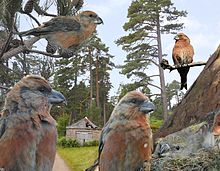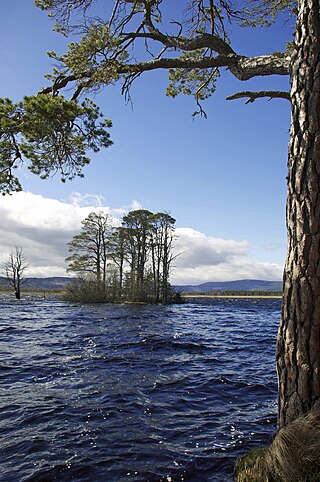
Loch Garten is a large Highland freshwater loch near Boat of Garten, in the Strathspey area of the Cairngorms National Park, in Scotland. It is surrounded by the tall pine trees of the Abernethy Forest, a large area of which is an RSPB nature reserve. The loch is renowned for its breeding population of ospreys, which lend Boat of Garten its nickname "The Osprey Village".

Crossbills are birds of the genus Loxia within the finch family (Fringillidae), with six species. These birds are characterized by the mandibles with crossed tips, which gives the group its English name. Adult males tend to be red or orange in color, and females green or yellow, but there is much variation.

The parrot crossbill is a small passerine bird in the finch family Fringillidae. It breeds in pine forests in northern and northeastern Europe.
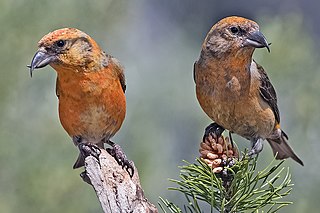
The red crossbill or common crossbill is a small passerine bird in the finch family Fringillidae. Crossbills have distinctive mandibles, crossed at the tips, which enable them to extract seeds from conifer cones and other fruits.
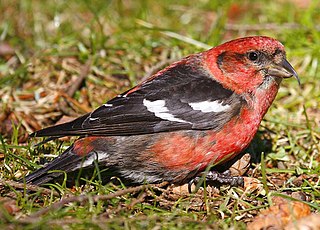
The two-barred crossbill or white-winged crossbill is a small passerine bird in the finch family Fringillidae. It breeds in the coniferous forests of North America and the Palearctic.

The Cairngorms are a mountain range in the eastern Highlands of Scotland closely associated with the mountain Cairn Gorm. The Cairngorms became part of Scotland's second national park on 1 September 2003. Although the Cairngorms give their name to, and are at the heart of, the Cairngorms National Park, they only form one part of the national park, alongside other hill ranges such as the Angus Glens and the Monadhliath, and lower areas like Strathspey.

The Caledonian Forest is the ancient (old-growth) temperate forest of Scotland. The forest today is a reduced-extent version of the pre-human-settlement forest, existing in several dozen remnant areas.

Pinus occidentalis, also known as the Hispaniolan pine or Hispaniola pine, is a pine tree endemic to the island of Hispaniola.
Natural history of Scotland concerns the flora, fauna and mycota of Scotland.

Abernethy Forest is a remnant of the Caledonian Forest in Strathspey, in the Highland council area of Scotland. It lies within the Cairngorms National Park, close to the villages of Nethy Bridge, Boat of Garten, and Aviemore. The forest is an RSPB reserve, close to Loch Garten Osprey Centre, which is also owned by the RSPB. It is popular with walkers, as there are various trails throughout the reserve. The forest forms part of the wider Abernethy National Nature Reserve.

The Hispaniolan crossbill is a crossbill that is endemic to the island of Hispaniola, and the only representative of the Loxia genus in the Caribbean.
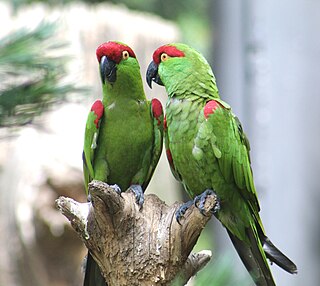
The thick-billed parrot is a medium-sized parrot endemic to Mexico that formerly ranged into the southwestern United States. Its position in parrot phylogeny is the subject of ongoing discussion; it is sometimes referred to as thick-billed macaw or thick-billed conure. In Mexico, it is locally called guacamaya ("macaw") or cotorra serrana. Classified internationally as Endangered through IUCN, the thick-billed parrot's decline has been central to multiple controversies over wildlife management. In 2018, the estimated wild population in Mexico was 1,700.

The fauna of Scotland is generally typical of the northwest European part of the Palearctic realm, although several of the country's larger mammals were hunted to extinction in historic times and human activity has also led to various species of wildlife being introduced. Scotland's diverse temperate environments support 62 species of wild mammals, including a population of wild cats, important numbers of grey and harbour seals and the most northerly colony of bottlenose dolphins in the world.
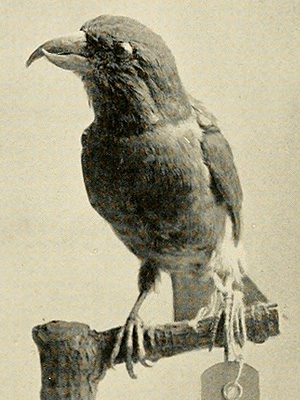
The Newfoundland red crossbill is a member of the crossbill genus which has its crossed bill adapted for prying open the tightly closed spruce or pine cones in order to extract the seeds found abundantly on the island of Newfoundland.

The flora of Scotland is an assemblage of native plant species including over 1,600 vascular plants, more than 1,500 lichens and nearly 1,000 bryophytes. The total number of vascular species is low by world standards but lichens and bryophytes are abundant and the latter form a population of global importance. Various populations of rare fern exist, although the impact of 19th-century collectors threatened the existence of several species. The flora is generally typical of the north-west European part of the Palearctic realm and prominent features of the Scottish flora include boreal Caledonian forest, heather moorland and coastal machair. In addition to the native species of vascular plants there are numerous non-native introductions, now believed to make up some 43% of the species in the country.
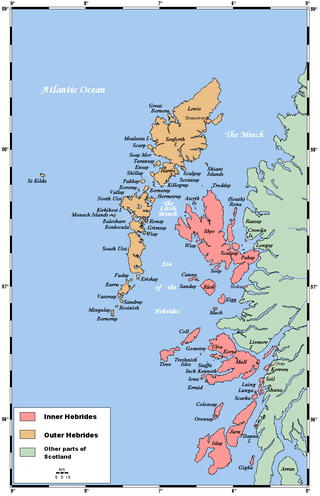
The flora and fauna of the Outer Hebrides in north west Scotland comprises a unique and diverse ecosystem. A long archipelago, set on the eastern shores of the Atlantic Ocean, it attracts a wide variety of seabirds, and thanks to the Gulf Stream a climate more mild than might be expected at this latitude. Because it is on the Gulf Stream, it also occasionally gets exotic visitors.

The Cassia crossbill is a passerine bird in the family Fringillidae. It is endemic to the South Hills and Albion Mountains in southern Idaho. Cassia crossbill rarely interbreeds with other call types that move into the South Hills of Idaho yearly, and can be considered to represent a distinct species via ecological speciation. The Cassia crossbill have specialized beaks to access the seeds of the lodgepole pine cones in this region, but are poorly adapted to other pine cones in surrounding regions.
Coregonus bavaricus, the Ammersee kilch, is a species of freshwater whitefish endemic to Lake Ammersee in the German state of Upper Bavaria. A small, silver-colored fish, it typically lives between 60–85 m (197–279 ft) deep, though shallower in the summer months. In the early 20th century the Ammersee kilch was an important commercial species, but its population declined drastically in the 1930s onward due to overfishing and eutrophication of the only lake in which it is found. Today it is listed as Critically Endangered by the International Union for Conservation of Nature (IUCN) and may be on the verge of extinction.

Scotland occupies the northern part of the United Kingdom. The landscape is diverse; ranging from rugged mountain terrain to arable flat land with many rivers and lochs.

Glen Tanar is a glen in Aberdeenshire, eastern Scotland, through which the Water of Tanar flows. Near the mouth of the glen, at Tower o' Ess, the Water of Tanar flows into the River Dee. This flows through Deeside into the North Sea at Aberdeen. Glen Tanar contains the third largest area of Caledonian Forest in Scotland, and is of national and European importance. It lies 29 km east from the British royal family's private residence of Balmoral Castle.
